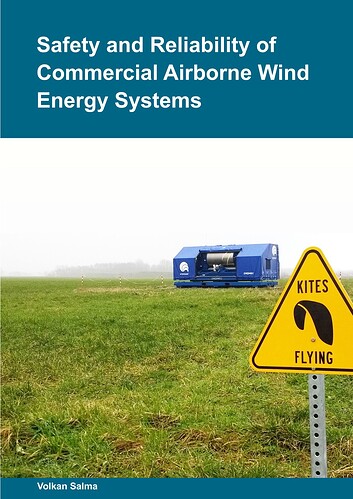Hi @rschmehl ,
This thesis asks good questions, shows good analyses, and provides some answers. Few points are quoted below.
Pages 1 and 2:
AWE systems typically operate in crosswind maneuvers, where the flight speed is closely coupled with both the wind speed and the reeling speed of the tether. This interdependence presents a significant operational challenge. Without responsive control, a wind gust can rapidly accelerate the flying device, which amplifies the aerodynamic loads; this leads to potential rupture of the tether or other irreversible damage —and in the worst -case—loss of the flying device or harm to people. For comparison: wind turbines are less prone to this coupling problem due to the large inertia of their blades.
Only or mainly crosswind maneuvers?
Page 2:
As AWE systems operate at higher altitudes and their operations are not stationary,
the interaction with the aviation system is potentially stronger. For these reasons, AWE
systems introduce risks to third parties in the air and objects on the ground. Thus, besides addressing the safety issues for wind turbines, such as the risk of lightning or fire within the equipment, additional considerations are required for managing aviation related risks.
There are stationary (“static”) AWES, for example rotary devices by torque transfer (SuperTurbine ™, Windswept & Interesting), or by rope drive transmission (Kiwee One).
Other stationary (“static”) AWES are also mentioned in the thesis itself, at least page 68:
6.6.3. REGULATIONS FOR TETHERED GAS BALLOONS CATEGORY
For static AWE systems that resemble the system developed by Altaeros Energies [118]
a more applicable basis is the EASA certification specification for tethered gas balloons,
CS-31TGB [119]. The lack of a complex control system which is required for the crosswind AWE systems, in conjunction with the self-stabilizing nature of a tethered lighterthan-air gas balloon will probably be sufficient to make CS-31TGB applicable.
Page 3:
However, it led to relatively slow development overall due to the following:
• lack of a holistic view of the systems to be developed [12];
• lack of a comprehensive systems engineering approach [13];
• lack of effective knowledge sharing and access to results (both successes and failed
attempts) [13]
Relevant observation.
Page 125:
B.1.1. FAILURES CAUSED BY TETHER FAULTS
In my opinion, other problems than faults could be blamed on tethers. Firstly their length linked to rapid movement in crosswind mode, leading to difficult secondary uses in regard to the reliability issues, and in large ground and space areas.
This publication could show that reliability problems would not be limited to the statement of faults, but could go as far as the choice of architectures retained.
